Monument
Mosteiro Santa Clara-a-Velha
The Monastery of Santa Clara-a-Velha is located on the left bank of the Mondego River, in the parish of Santa Clara e Castelo Viegas, in the city of Coimbra, and is classified as a National Monument.
It represents a moment of experimentation with the Gothic style in our country. The appeal of the way of life proposed by Santa Clara led Dona Mor Dias, a noble lady from Coimbra, to found a house of Poor Clares.
In April 1283, she obtained a licence to build a monastery dedicated to Santa Clara, the first stone of which was laid in 1286, near the Franciscan convent that was also on the left bank of the Mondego River.
In 1302, its founder bequeathed her property and income to it.
From 1307 onwards, Saint Isabel of Aragon, Queen of Portugal, took an interest in the convent and devoted much of her time and wealth to its enhancement.
Work on the second building began in 1316, funded by the queen, and in 1317 the first nuns, from Zamora, moved in.
The Queen ordered the construction of a hospital for the poor next to the monastery, with a cemetery, chapel and palace, where D. Pedro and D. Inês de Castro later lived, and where she was executed in 1355.
The architect responsible for the works was Domingos Domingues, who was later replaced by Master Estevão Domingues to complete the church and begin construction of the cloisters of the Monastery of Santa Clara.
These stand out on the national scene for their grandeur, being the largest in the Gothic style.
For a long time, the monastery was home to the Poor Clares, who lived in seclusion.
These nuns left behind an important collection of porcelain and earthenware, rosaries, rings and many other objects that allow us to reconstruct their daily lives, on display in an exhibition at the interpretive centre, which houses ‘the history of the site’.
After King Dinis of Portugal died in 1325, Queen Isabel retired to the monastery.
She took the habit of the Poor Clares but did not take vows, which allowed her to keep her fortune, which she used for charity.
Over the centuries, the life of the monastery was marked by successive floods caused by the Mondego River, the first of which occurred in 1331, heralding a difficult coexistence with the waters.
The solution found over the centuries was to raise the ground floor until, in the 17th century, the nuns were forced to vacate the lower floor and build an upper floor
along the temple.
The deterioration of the building due to constant flooding led to its definitive abandonment in 1677. The monastery and everything around it gave way to a farm, with the upper part of the convent being used as housing, a hayloft and corrals.
The old monastery became known as the Monastery of Santa Clara-a-Velha.
From the 1930s onwards, the convent underwent extensive restoration work, but continued to suffer from the river’s waters.
In this unoccupied space, immersed in sediments that left only the upper part of the church visible, archaeological campaigns carried out between 1995 and 2000 allowed for the collection of a significant amount of material, material evidence of the convent’s past.
The project to restore the old monastery, launched in 2004, included the construction of a building to house the Interpretation Centre.
Unfortunately, in January 2016, the waters of the Mondego River flooded the monastery again, causing the loss of equipment in the Interpretation Centre and documents, as the water level reached five metres.





